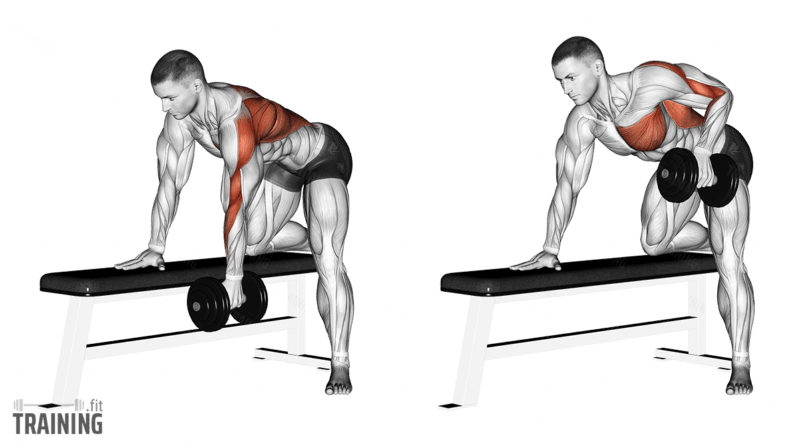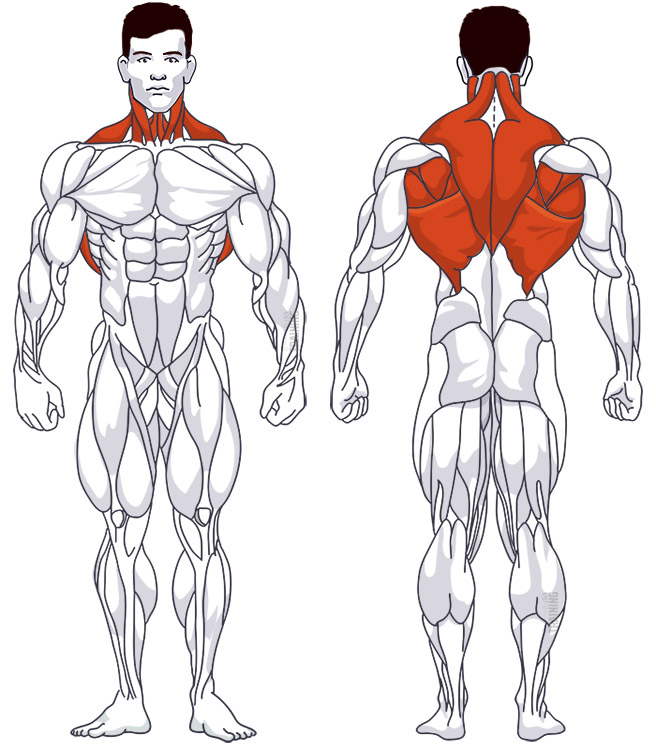Single Arm Dumbbell Row
Isolation exercise, Free weightsOverview

Main muscles
- Neck: Trapezius muscle
(Musculus trapezius) - Back: Large round muscle
(Musculus teres major) - Back: Large back muscle
(Musculus latissimus dorsi) - Back: Larger rhomboid muscle
(Musculus rhomboideus major) - Back: Small round muscle
(Musculus teres minor)
Training plans
Here you can find example plans for single arm dumbbell row training:
Single Arm Dumbbell Row: Basics and alternatives

Involved main muscle groups:
Single Arm Dumbbell Row
The single-arm dumbbell row is a popular exercise for working your back and rear shoulders. While supporting yourself with one arm, you’ll kneel on a flat bench and move the dumbbell with the other arm. This posture is easy to learn, stable, and perfect for beginners.
Single-arm dumbbell rowing is an alternative to barbell rowing, but it doesn’t stress the lower back due to less body tension. For a two-arm exercise, you can also perform the lying incline dumbbell row. Additionally, you can row on a machine or use a cable pulley.
The main advantage of single-arm rowing is the better isolation of one side of the body, allowing you to focus on proper execution, especially for the weaker side. However, this can also be a disadvantage, as other rowing variations help the weaker side adapt better to the stronger side in terms of strength and form over time. When rowing with one arm, make sure the execution is identical on both sides.
Correct execution
For single-arm dumbbell rows, you’ll need a flat bench and a dumbbell. If you don’t have a bench, you can replace it with a sturdy, long piece of furniture for home workouts.
It’s crucial to have enough space to support your knee and arm, and for your upper body to extend freely. This ensures your back doesn’t round unintentionally and allows for a full range of motion.
Video tutorial
Step-by-step instructions
Place the dumbbell to the side of the flat bench.
Put your non-training side knee on the flat bench and lean your upper body forward. Support yourself on the bench with the same side arm. Your upper body should be straight with a slight arch in your back. Your other leg should be positioned next to the bench, firmly on the floor.
Lift the dumbbell off the floor. Your arm should be extended and in line with your shoulder. This is your starting position.
Begin the movement by lifting the dumbbell towards your chest. The movement should come from your back, not your biceps. Raise your elbow towards your torso and bend it at the same time. At the end of the movement, your elbow should be about shoulder height and bent to 90 degrees (between upper and lower arm).
After a brief pause, lower the weight by extending your elbow and returning the dumbbell to the starting position.
Common mistakes
Using momentum and swinging the dumbbell is a big no-no in single-arm rowing. Make sure to lift and lower the dumbbell in a controlled manner without rushing the movement.
Also, ensure that your back is straight with a slight arch and not rounded. Your upper body should remain stationary throughout the exercise.
Another mistake is not giving your upper body enough space, which can lead to a slightly rounded back. This limits your range of motion and reduces the involvement of targeted muscle groups. If you don’t have enough room and still try to pull your elbow up to shoulder height, your neck will work harder than your latissimus dorsi. So, choose a spot that allows you to position your body optimally on the bench.